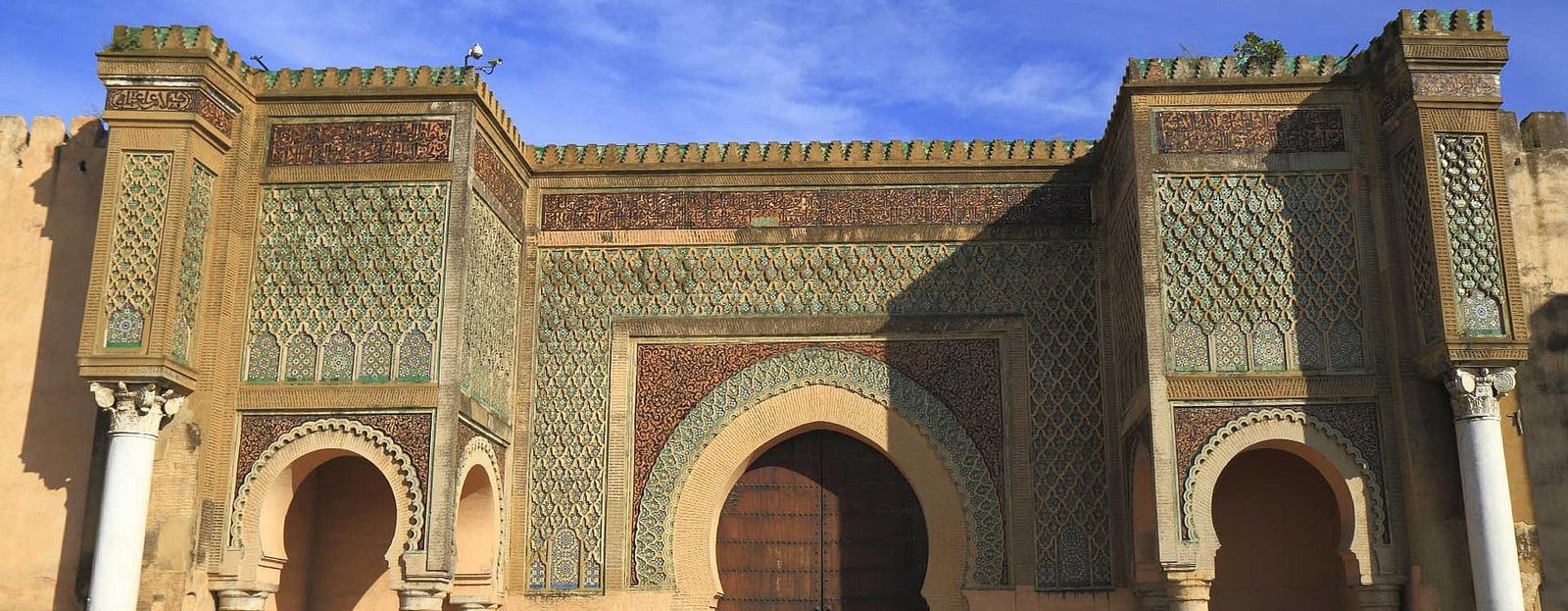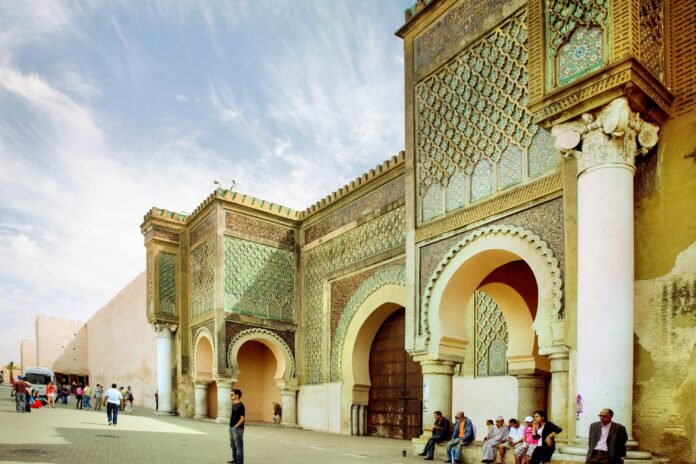Introduction
Greetings readers! Today, I would like to share my experience visiting two magnificent sites in the Moroccan city of Meknes – Bab Mansour and the Mausoleum of Moulay Ismail. Both sites exemplify the imperial grandeur and architectural splendor for which Meknes was renowned during its peak under Sultan Moulay Ismail in the 17th century.
A bit of background – Meknes is located around 80km from Fez in northern Morocco. During the reign of Moulay Ismail from 1672 to 1727, it served as the capital city. It saw tremendous growth and development as the Sultan sought to establish an impressive new seat of power to rival cities like Fez and Marrakesh. Considered the “Versailles of Morocco,” Meknes, in its imperial heyday, was home to lavish palaces, gardens, and monuments built with materials and techniques borrowed from across the Islamic and European worlds.
While only ruins remain today, walking through sites like Bab Mansour and the Mausoleum gives visitors a glimpse into Meknes’ storied past. I was fortunate to experience them on a recent trip, and in this post, I aim to share the splendors I witnessed through vivid descriptions and personal reflections. I hope reading about my visit inspires others to make the journey to see these historical treasures for themselves.
Meknes: Bab Mansour and Gateway to a Grand Imperial Vision
On entering the Medina quarter containing Bab Mansour, the first thing that struck me was its immense scale. Towering over surrounding homes and alleys, the arched entranceway loomed large against the skyline like a monumental gateway between the everyday world and a realm of royal majesty.
Approaching closer, intricate zellij tilework and carvings came into sharp relief, adorning multistory facades on either side of the arched passageway. Geometric and floral patterns in vibrant blues, greens, and oranges drew the eye upward toward lofty heights. It was immediately evident this was no ordinary gate – it exuded a symbolic grandeur befitting an entrance to the seat of an empire.
Stepping within the arched portal, the sense of entering a place profoundly separate from the outside grew stronger. Looking ahead, corridors stretched further than the eye could see into the empty distance, flanked by towering walls. It felt like passing through a doorway in time and space into the echoing remains of Moulay Ismail’s grand vision.
Wandering those corridors gave a sense of the immense scale on which the Bab Mansour complex was conceived – its multiple passages, courtyards, and dead ends suggesting a sprawling mini-city within the walls. Crenelated battlements and ornate decorative programs bore witness to a prodigious expenditure of resources and craft. Imagining this area in its imperial pomp was dizzying, thronged with courtly activity.
Perhaps what struck me most was how the grand impression of the Bab Mansour outlived its physical fragments. Its crumbling architecture conveyed an aura of faded glory that still inspired awe and transported the imagination back to Meknes’ time at the pinnacle of Western Islamic civilization under Sultan Moulay Ismail. History had reduced it to hints and echoes of its former magnificence, yet this enhanced rather than diminished its effect. It revealed imperial grandeur can leave indelible marks on the human imagination long after structures crumble into dust.
After absorbing the evocative atmosphere within those sun-bleached ruined walls for some time, I exited the southerly gate feeling stirred. The ruins left me eager to learn more about the Meknes of Moulay Ismail’s time and hopeful of seeing vestiges of its former splendors elsewhere. My next stop would be the Mausoleum – what secrets and impressions might that storied site hold?
Meknes: The Imperial Mausoleum and A Glimpse of Eternal Majesty
Stepping inside the Mausoleum’s ornate gateway, lush gardens spread before me, dotted with towering palms and flower bushes. Marble-paved paths wound between manicured lawns and fountains, infusing the surroundings with an aura of calm and reverence. It felt a world apart from the bustle outside as if transporting visitors inside a sacred paradise.
Moving deeper amongst neatly trimmed foliage, the Mausoleum complex gradually appeared. A forest of slender marble minarets rose skywards from the treetops; their pointed spires streaked azure and white. Approaching closer, the minarets encircled a grand domed chamber resplendent in zellij tilework, which could only be the Mausoleum itself.
Pausing before the entrance, I was transfixed by the dome’s intricate mosaic patterns radiating from a central floral medallion. Blues, greens, and gold mingled in swirling geometries, conveying a sense of the infinite within a finite space. It was a tour de force of traditional Moroccan craftsmanship, breathtaking in its delicate beauty and grandeur of conception.
Stepping inside, the effect was no less potent. Marble colonnades encircled a soaring central chamber, and the walls and floor were elaborately clad in polychrome tilework. Light filtering through stained glass windows illuminated ornate carvings and calligraphy, placing worshippers in direct communion with their artistic splendor. Majestic yet soothing, it felt both ethereal and firmly grounded – a fitting final resting place for an emperor who stamped his indelible mark on this earthly realm.
That day, I was one of only a few visitors fortunate enough to glimpse Moulay Ismail’s tomb amidst the grand surroundings. Approaching slowly, taking in elaborate inscriptions and decorations, I pondered this enigmatic figure who could conjure such a monument to his eternal repose. For all his fearsome reputation, this Mausoleum conveyed an aura of infinite majesty, beauty, and sanctity, befitting his status as a sovereign and spiritual figurehead.
Emerging once more into the garden setting, feelings of profound reflection lingered. This serene oasis had granted a privileged audience with imperial grandeur on its terms – majestic yet cognizant of human impermanence. It was an experience that would stay with me for its lessons of how great creative works can outlive even the most powerful rulers to offer ongoing inspiration to generations.

Leaving the Mausoleum grounds that afternoon, I felt grateful for having been able to glimpse these storied sites and perceive fragments of Meknes’ imperial history usually lost to the ravages of time. Where once a seat of a Western Islamic empire stood in full glittering splendor, today, only ruins remain. Yet what ruins – in their crumbling stones and fading tilework, Bab Mansour and the Imperial Mausoleum continue transmitting an enduring message. They testify that true creative works born of vision and craftsmanship can withstand the destruction of centuries to leave impacts that inspire awe and reflection long after their builders have returned to dust.
My visit to Meknes allowed me a privileged window into this lesson. Wandering those evocative ruins in contemplative solitude, I felt a profound connection to the artisans, architects, and leaders who envisioned and gave life to such places in Moulay Ismail’s time. Their creative works have shaped buildings and the city’s identity and story across the generations. In small ways, sites like Bab Mansour and the Mausoleum continue reshaping visitors even today through the impressions and perspectives they offer. They remind us that great pursuits born of vision, skill, and conviction can achieve permanence through the spirits and imaginations they continue to stir.
I left Meknes feeling eternally grateful for the opportunity to learn from its monuments, and hopeful others will be inspired to discover their messages. More than crumbling edifices, these ruins convey eternal verities about creativity, legacy, and human striving that remain profoundly relevant. I wish that sharing recollections of my visit may motivate fresh pilgrims to experience Meknes’ majesty for themselves – and thus ensure its lessons of grandeur, impermanence, and vision continue rippling outward through the ages. The city’s imperially conceived treasures yield lessons to enrich contemporary lives centuries after their construction if only we could glimpse them.
I hope this personal account from my travels offered a compelling window into imperial Meknes’ enduring wonders. Sites like Bab Mansour and the Mausoleum showcase the pinnacles of craft and vision attainable when a leader endows a city with the resources and direction to achieve grand cultural achievements. Though only ruins remain, wandering their grounds stirs impressions that feel just as vivid today. Perhaps most inspiring is perceiving how creative works born of proper vision can leave impacts transcending centuries by the impressions and perspectives they continue to convey. I wish that sharing recollections of Meknes’ majesty may motivate fresh pilgrims to experience its lessons and ensure its inspirations echo through the ages.

